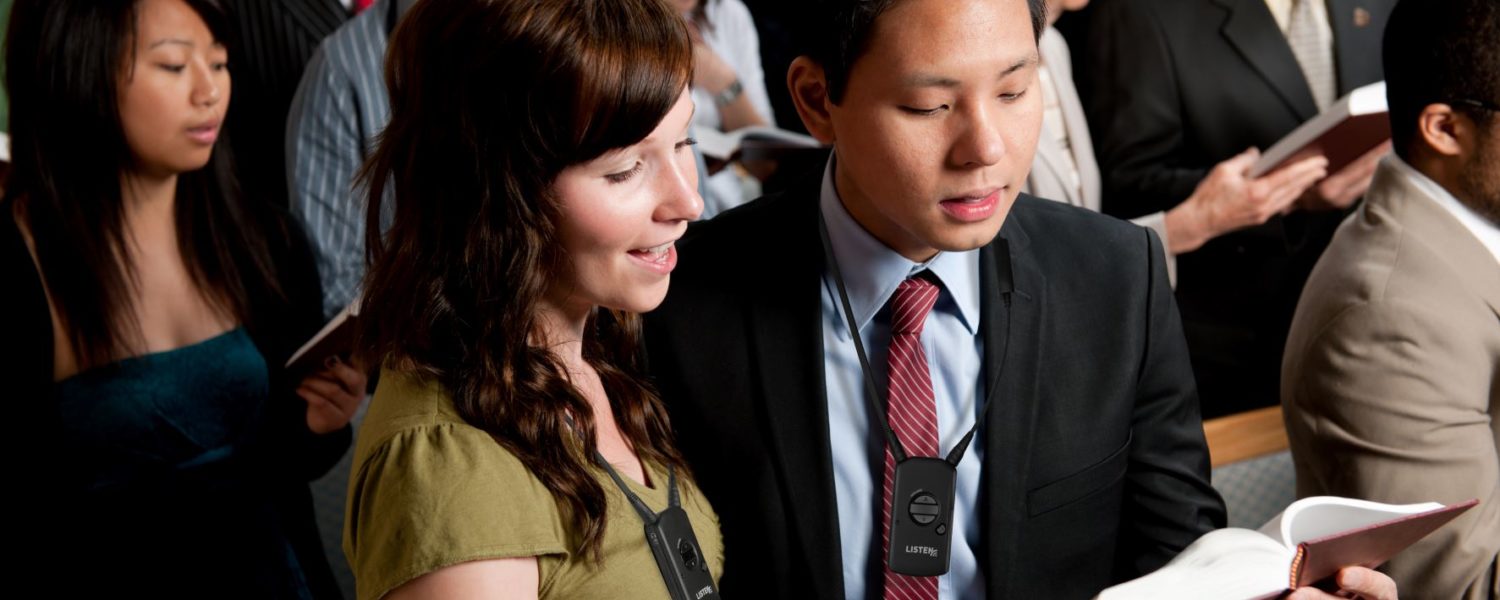By Carrie Kaumans
As restrictions are lifted, houses of worship, once shuttered because of COVID-19 transmission fears, are reopening. Numbers suggest that people are returning to in-person worship. That’s good news!
So is this truth: Churches, synagogues, mosques, and other places of worship have unique opportunities to reconnect with congregants and visitors and make their return to in-person worship more engaging and meaningful than before the pandemic.
One way they can do this is by improving their audio systems with assistive listening technology. Audio is a crucial element of in-person worship. Sermons, hymns, and prayers spoken aloud can offer comfort, inspiration, and encouragement; however, when hearing loss, background noise, distance, or poor acoustics (think high ceilings and hard surfaces common in many churches) make hearing and understanding challenging or impossible, the experience is diminished. Worshippers may feel frustrated, distracted, isolated, embarrassed, and they may simply check out.
Contrast this experience with the experience of worshippers who attended services virtually during pandemic closures. While many may have missed the fellowship of in-person services, being able to stream church services and watch them on-demand meant worshippers could move to a quiet location free of distractions and adjust the volume and audio settings on their devices to meet their unique hearing needs.
Assistive listening systems in houses of worship function similarly, facilitating hearing and improving intelligibility for all users by delivering clear sound directly to their ears. Congregants can gather safely in person to share in worship while experiencing personalized sound.
Radio Frequency Assistive Listening
There are multiple assistive listening technologies, but one that is especially well suited for houses of worship is radio frequency technology. Radio frequency systems are cost effective and ADA (Americans with Disabilities Act) compliant.
Unlike infrared technology that requires receivers to be in line of sight with transmitters, radio frequency passes through walls, making it ideal for spaces with annexes or adjoining rooms such as fellowship halls, chapels, Sunday School classrooms, and vestibules.
How It Works
Radio frequency assistive listening systems are simple to install and operate – an important consideration for houses of worship that may not have dedicated IT and AV professionals on staff. Audio sources such as microphones, TVs, or speakers are connected to transmitters. Sound from audio sources is transmitted over radio frequency to small receivers that listeners carry or wear on a lanyard around their neck.
Listeners hear sound through headphones (either their own or church-provided headsets/headphones) plugged into the receiver or directly through their hearing aids or cochlear implants via a neckloop. They can select the channel and adjust the volume to suit their preferences.
Because ambient noise is not amplified, listeners only hear clear, intelligible audio; no straining to hear and understand a speaker’s words over the din of background sounds. Radio frequency receivers and headsets can be cleaned with disinfecting wipes, charged quickly, and stored easily between uses.
Houses of worship that offer assistive listening systems often use physical signage to promote their availability and usage. They may also share information about devices and usage instructions on their websites, in weekly bulletins, and on social media.
Other ways to let congregants know about the systems include announcements before services, video/YouTube demonstrations, and system champions. These could be ushers, greeters, small group leaders, or anyone familiar with the system and willing to promote their availability.
Overcoming Language Barriers
More than 5% of the world’s population, or 430 million people, require rehabilitation to address disabling hearing loss, and 15% of Americans aged 18 and older report trouble hearing. Hearing loss is on the rise among young people, and older adults tend to experience hearing loss as a result of aging. Clearly, there is a need for assistive listening technology in houses of worship, but systems can also foster inclusion among worshippers beyond just assistive listening.
Houses of worship with multi-lingual congregations are using radio frequency assistive listening systems to overcome language barriers.
At Walnut Street Baptist Church in Newark, New Jersey, for example, most worshippers speak Portuguese and attend Portuguese services. In many instances, their English-speaking children and grandchildren do not understand Portuguese, yet they are able to attend services together, thanks to a radio frequency assistive listening system. A translator at the church translates from Portuguese to English. Worshippers who do not speak Portuguese are able to check out a receiver and headset, select the audio channel featuring the translator, and listen to the service in English.
As places of worship celebrate a return to in-person services, radio frequency assistive listening systems offer an easy, practical way to support re-engagement and foster inclusion. Attendees can experience personalized audio that meets their unique listening needs while in community with other worshippers. That’s good news indeed.
Carrie Kaumans is corporate channel marketing manager at Listen Technologies, a leading provider of advanced wireless listening solutions for 23 years. Listen Technologies enriches lives by delivering audio directly to the individual so everyone can hear clearly and share in the same great experience, www.listentech.com.










